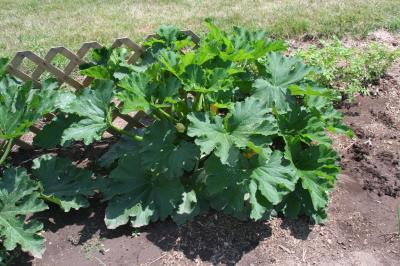Summer squash (also known as vegetable or Italian marrow), is a tender, warm-season vegetable that can be grown throughout the United States anytime during the warm, frost-free season. Summer squash differs from fall and winter squash in that it is selected to be harvested before the rind hardens and the fruit matures. It grows on bush-type plants that do not spread like the plants of fall and winter squash and pumpkin. A few healthy and well-maintained plants produce abundant yields. Any well-drained garden soil produces excellent yields of summer squash. Certain mulches increase earliness and yields, because the roots are shallow.
Summer squash appears in many different fruit shapes and colors: Scallop or Patty Pan is round and flattened like a plate with scalloped edges, usually white but sometimes yellow or green. Constricted neck is thinner at the stem end than the blossom end, classified as either "crookneck" or "straightneck" depending on if the stem end is straight or bent, and is usually yellow. Cylindrical to club-shaped Italian marrows, such as zucchini, cocozelle and caserta, are usually shades of green, but may be yellow or nearly white.
The varietal selection of summer squash has markedly changed in recent years and the number of varieties offered has greatly expanded as the result of new interest, hybridization and introduction of disease resistance. The number of varieties is staggering.
Recommended varieties of summer squash include:
- Zucchini (Open Pollinated): Black Zucchini (best known summer squash; greenish black skin, white flesh), Black Beauty (slender, with slight ridges, dark black-green), Cocozelle (dark green overlaid with light green stripes; long, very slender fruit)
- Vegetable Marrow: White Bush (creamy greenish color, oblong shape) Zucchini (hybrid), Aristocrat (All America Selection winner; waxy; medium green), Chefini (AAS winner; glossy, medium dark green), Classic (medium green; compact, open bush), Elite (medium green; lustrous sheen; extra early; open plant), Embassy (medium green, few spines, high yield), President (dark green, light green flecks; upright plant), Spineless Beauty (medium dark green; spineless petioles), Golden Zucchini (hybrid) Gold Rush (AAS winner, deep gold color, superior fruit quality, a zucchini not a straightneck)
- Yellow Crookneck: Early Yellow Summer Crookneck (classic open-pollinated crookneck; curved neck; warted; heavy yields), Sundance (hybrid; early; bright yellow, smooth skin)
- Yellow Straightneck: Early Prolific Straightneck (standard open-pollinated straightneck, light cream color, attractive straight fruit), Goldbar (hybrid; golden yellow; upright, open plant)
- Scallop White: Bush Scallop (old favorite Patty Pan type, very pale green when immature, very tender), Peter Pan (hybrid, AAS winner, light green), Scallopini (hybrid, AAS winner), Sunburst (hybrid, bright yellow, green spot at the blossom end)
- Other: Butter Blossom (an open-pollinated variety selected for its large, firm male blossoms; fruit may be harvested like summer squash, but remove female blossoms for largest supply of male blossoms), Gourmet Globe (hybrid; globe-shaped; dark green, with light stripes; delicious), Sun Drops (hybrid, creamy yellow, unique oval shape, may be harvested as baby with blossoms attached).
Plant anytime after the danger of frost has passed, from early spring until midsummer. Some gardeners have two main plantings - one for early summer harvest and another for late summer and fall harvest.
Because summer squash develop very rapidly after pollination, they are often picked when they are too large and overmature. They should be harvested when small and tender for best quality. Most elongated varieties are picked when they are 2 inches or less in diameter and 6 to 8 inches long. Patty Pan types are harvested when they are 3 to 4 inches in diameter. Slightly larger fruit may be salvaged by hollowing out and using them for stuffing. These larger fruits may also be grated for baking in breads and other items. Do not allow summer squash to become large, hard and seedy because they sap strength from the plant that could better be used to produce more young fruit. Pick oversized squash with developed seeds and hard skin and throw them away. Go over the plants every 1 or 2 days. Squash grow rapidly; especially in hot weather and are usually ready to pick within 4 to 8 days after flowering.
Sow two or three seeds 24 to 36 inches apart for single-plant production, or four or five seeds in hills 48 inches apart. Cover one inch deep. When the plants are 2 to 3 inches tall, thin to one vigorous plant or no more than two or three plants per hill.
Bacterial Disease
Environmental Damage
Fungal Disease
Herbicide Injury
Insect Damage
Insect Relative Damage
Additional pests and problems that may affect this plant:
Insects and insect relatives:
- Aphids
- Seed corn maggots
- Leafhoppers
- Thrips
Diseases
- Fusarium crown and fruit rot (Fusarium solani f.sp. cucurbitae)
- Fusarium wilt (Fusarium oxysporum)
- Plectosporium blight (Plectosporium tabacinum)
- Root knot nematode (Meloidogyne spp.)
- Viral diseases: cucumber mosaic, Papaya ringspot, Squash mosaic, Watermelon mosaic, and Zucchini yello mosaic
